Quantification and Analysis of Microplastics in Farmland Soils: Characterization, Sources, and Pathways
Abstract
1. Introduction
| Region | MP Source | Sampling Depth | No. of Soil Samples (Excluding Control Samples) | Main Extraction Method | Identification Method | Unit | Reference |
|---|---|---|---|---|---|---|---|
| Chile | sludge application | 0–25 cm | 93 | Centrifuge, density separation by NaCl and ZnCl2 | Stereo microscope | Particles/5 g−1 dry weight | [28] |
| China | pig manure | ~20 cm | 20 | Continuous air-flow flotation separation, Density separation by NaCl | Stereo microscope, ATR-FTIR, scanning electron microscope (SEM) | Particles/kg dry weight | [30] |
| China | plastic mulching | 20 cm | 20 | Wet sieving, density separation, carbonation | SEM, ATR-FTIR | Numbers/kg dry mass | [31] |
| China | Large traffic flow, domestic wastes, and agricultural activities | top 5 cm | 20 | Density separation by ZnCl2 | Stereo microscope, micro-Raman spectroscopy | Items/kg dry weight | [32] |
| Spain | plastic mulching | 0–10 cm | 9 | Centrifuge, ultrasonic bath | Stereo microscope | Particles/kg dry matter | [29] |
| Germany | application of manure, littering, mulching, and silage | 0–10 cm, 10–20 cm and 20–30 cm | 540 | Wet sieving | Stereo microscope, FTIR | MP/kg dry weight | [33] |
| Taiwan | Historical fish farming, fruit protective foam, nearby roads, mulch, plastic debris | 0–5 cm, 20–25 cm | 150 | Density separation by NaCl | Stereo microscope, ATR-FTIR | MP items/m2 | Present study |
2. Materials and Methods
2.1. Study Area
2.2. Sampling Strategy
2.3. MP Extraction
2.4. MP Identification and Characterization
2.5. Statistical Analysis
2.6. Quality Assurance (QA) and Quality Control (QC)
3. Results and Discussion
3.1. Abundance and Distribution of MPs
3.2. MP’s Size Distribution
3.3. MP’s Shape and Identification
3.4. MP Identification
3.5. Challenges and Limitation
4. Conclusions
Author Contributions
Funding
Data Availability Statement
Acknowledgments
Conflicts of Interest
References
- Geyer, R.; Jambeck, J.R.; Law, K.L. Production, use, and fate of all plastics ever made. Sci. Adv. 2017, 3, e1700782. [Google Scholar] [CrossRef]
- Wright, S.L.; Kelly, F.J. Plastic and human health: A micro issue? Environ. Sci. Technol. 2017, 51, 6634–6647. [Google Scholar] [CrossRef] [PubMed]
- Gewert, B.; Plassmann, M.M.; MacLeod, M. Pathways for degradation of plastic polymers floating in the marine environment. Environ. Sci: Process Impacts 2015, 17, 1513–1521. [Google Scholar] [CrossRef] [PubMed]
- Kunz, A.; Walther, B.A.; Löwemark, L.; Lee, Y.C. Distribution and quantity of microplastic on sandy beaches along the northern coast of Taiwan. Mar. Pollut. Bull. 2016, 111, 126–135. [Google Scholar] [CrossRef] [PubMed]
- Frias, J.P.G.L.; Nash, R. Microplastics: Finding a consensus on the definition. Mar. Pollut. Bull. 2019, 138, 145–147. [Google Scholar] [CrossRef]
- Liu, M.; Lu, S.; Song, Y.; Lei, L.; Hu, J.; Lv, W.; Zhou, W.; Cao, C.; Shi, H.; Yang, X.; et al. Microplastic and mesoplastic pollution in farmland soils in suburbs of Shanghai, China. Environ. Pollut. 2018, 242, 855–862. [Google Scholar] [CrossRef]
- Horton, A.A.; Walton, A.; Spurgeon, D.J.; Lahive, E.; Svendsen, C. Microplastics in freshwater and terrestrial environments: Evaluating the current understanding to identify the knowledge gaps and future research priorities. Sci. Total Environ. 2017, 586, 127–141. [Google Scholar] [CrossRef] [PubMed]
- Kawecki, D.; Nowack, B. Polymer-Specific Modeling of the Environmental Emissions of Seven Commodity Plastics as Macro- and Microplastics. Environ. Sci. Technol. 2019, 53, 9664–9676. [Google Scholar] [CrossRef]
- Arthur, C.; Baker, J.; Bamford, H. International Research Workshop on the Occurrence, Effects, and Fate of MP Marine Debris; Technical Memorandum NOS-OR&R-30; NOAA: Tacoma, WA, USA, 2009; p. 530.
- Li, L.; Luo, Y.; Peijnenburg, W.J.G.M.; Li, R.; Yang, J.; Zhou, Q. Confocal measurement of microplastics uptake by plants. MethodsX 2020, 7, 100750. [Google Scholar] [CrossRef]
- Cole, M.; Lindeque, P.; Halsband, C.; Galloway, T.S. Microplastics as contaminants in the marine environment: A review. Mar. Pollut. Bull. 2011, 62, 2588–2597. [Google Scholar] [CrossRef]
- Shonbeck, M.W.; Evanylo, G.K. Effects of Mulches on Soil Properties and Tomato Production I. Soil Temperature, Soil Moisture and Marketable Yield. J. Sustain. Agric. 1998, 13, 55–81. [Google Scholar] [CrossRef]
- Kasirajan, S.; Ngouajio, M. Polyethylene and biodegradable mulches for agricultural applications: A review. Agron. Sustain. Dev. 2012, 32, 501–529. [Google Scholar] [CrossRef]
- Waggoner, P.E.; Miller, P.M.; De Roo, H. Plastic mulching: Principles and benefits. Conn. Agric. Expt. Station. Bull. 1960, 634, 44. [Google Scholar]
- Shah, F.; Wu, W. Chapter Five—Use of plastic mulch in agriculture and strategies to mitigate the associated environmental concerns. Adv. Agron. 2020, 164, 231–287. [Google Scholar]
- Lambert, S.; Wagner, M. Environmental performance of bio-based and biodegradable plastics: The road ahead. Chem. Soc. Rev. 2017, 46, 6855–6871. [Google Scholar] [CrossRef]
- United Nations Environmental Program (UNEP). Marine Plastic Debris and Microplastics: Global Lessons and Research to Inspire Action and Guide Policy Change; UNEP: Nairobi, Kenya, 2016; pp. 1–274. [Google Scholar]
- Wang, J.; Liu, X.; Li, Y.; Powell, T.; Wang, X.; Wang, G.; Zhang, P. Microplastics as contaminants in the soil environment: A mini-review. Sci. Total Environ. 2019, 691, 848–857. [Google Scholar] [CrossRef]
- Wiesner, Y.K.; Müller, A.; Bannick, C.G.; Bednarz, M.; Braun, U. Pathways of microplastics in soils—Detection of microplastic contents in compost using a thermal decomposition method. In Proceedings of the 22nd EGU General Assembly, Vienna, Austria, 4–8 May 2020; EGU2020-22456. [Google Scholar] [CrossRef]
- Simon, N.; Schulte, M.L. Stopping Global Plastic Pollution: The Case for an International Convention; Heinrich-Böll-Foundation: Berlin, Germany, 2017; Volume 43, pp. 1–56. [Google Scholar]
- Giuffrè, A.M.; Louadj, L.; Rizzo, P.; De Salvo, E.; Sicari, V. The Influence of Film and Storage on the Phenolic and Antioxidant Properties of Red Raspberries (Rubus idaeus L.) cv. Erika. Antioxidants 2019, 8, 254. [Google Scholar] [CrossRef] [PubMed]
- Mills, N.J. (Report 167) Polyolefin Foams; Rapra Review Reports; iSmithers Rapra Publishing: Shropshire, UK, 2003; Volume 14, ISSN 0889-3144. [Google Scholar]
- Khan, R.K.; Strand, M.A. Road dust and its effect on human health: A literature review. Epidemiol. Health 2018, 40, e2018013. [Google Scholar] [CrossRef] [PubMed]
- Abbasi, S.; Keshavarzi, B.; Moore, F.; Delshab, H.; Soltani, N.; Sorooshian, A. Investigation of microrubbers, microplastics and heavy metals in street dust: A study in Bushehr city, Iran. Environ. Earth. Sci. 2017, 76, 798. [Google Scholar] [CrossRef]
- Sommer, F.; Dietze, V.; Baum, A.; Sauer, J.; Gilge, S.; Maschowski, C.; Gieré, R. Tire Abrasion as a Major Source of Microplastics in the Environment. Aerosol Air Qual Res. 2018, 18, 2014–2028. [Google Scholar] [CrossRef]
- Knight, L.J.; Parker-Jurd, F.N.F.; Al-Sid-Cheikh, M.; Thompson, R.C. Tyre wear particles: An abundant yet widely unreported microplastic? Environ. Sci. Pollut. Res. 2020, 27, 18345–18354. [Google Scholar] [CrossRef]
- Hurley, R.R.; Nizzetto, L. Fate and occurrence of micro(nano)plastics in soils: Knowledge gaps and possible risks. Curr. Opin. Environ. Sci. Health 2018, 1, 6–11. [Google Scholar] [CrossRef]
- Corradini, F.; Meza, P.; Eguiluz, R.; Casado, F.; Huerta-Lwanga, E.; Geissen, V. Evidence of microplastic accumulation in agricultural soils from sewage sludge disposal. Sci. Total Environ. 2019, 671, 411–420. [Google Scholar] [CrossRef]
- Beriot, N.; Peek, J.; Zornoza, R.; Geissen, V.; Huerta Lwanga, E. Low density-microplastics detected in sheep faeces and soil: A case study from the intensive vegetable farming in Southeast Spain. Sci. Total Environ. 2021, 755, 142653. [Google Scholar] [CrossRef] [PubMed]
- Yang, J.; Li, R.; Zhou, Q.; Li, L.; Li, Y.; Tu, C.; Zhao, X.; Xiong, K.; Christie, P.; Luo, Y. Abundance and morphology of microplastics in an agricultural soil following long-term repeated application of pig manure. Environ Pollut. 2021, 272, 116028. [Google Scholar] [CrossRef] [PubMed]
- Li, W.; Wufuer, R.; Duo, J.; Wang, S.; Luo, Y.; Zhang, D.; Pan, X. Microplastics in agricultural soils: Extraction and characterization after different periods of polythene film mulching in an arid region. Sci. Total Environ. 2020, 749, 141420. [Google Scholar] [CrossRef]
- Chen, Y.; Leng, Y.; Liu, X.; Wang, J. Microplastic pollution in vegetable farmlands of suburb Wuhan, central China. Environ. Pollut. 2020, 257, 113449. [Google Scholar] [CrossRef]
- Harms, I.K.; Diekötter, T.; Troegel, S.; Lenz, M. Amount, distribution and composition of large microplastics in typical agricultural soils in Northern Germany. Sci. Total Environ. 2021, 758, 143615. [Google Scholar] [CrossRef]
- Taiwan Environmental Protection Administration. Electronic Environmental Policy Monthly; Taiwan Environmental Protection Administration: Taipei City, Taiwan, 2018; Volume XXIII, p. 12. ISSN 1811–4008.
- Ritchey, E.L.; McGrath, J.M.; Gehring, D. Determining Soil Texture by Feel. Agric. Nat. Resour. Publ. 2015, 4, 139. [Google Scholar]
- Thien, S.J. A flow diagram for teaching texture by feel analysis. J. Agron. Educ. 1979, 8, 54–55. [Google Scholar] [CrossRef]
- Wang, Z.; Taylor, S.E.; Sharma, P.; Flury, M. Poor extraction efficiencies of polystyrene nano- and microplastics from biosolids and soil. PLoS ONE 2018, 13, e0208009. [Google Scholar] [CrossRef]
- Schoeneberger, P.; Wysocki, D.; Benham, E.; Staff, S.S. Field Book for Describing and Sampling Soils; Version 3.0; Natural Resources Conservation Service; National Soil Survey Center: Lincoln, NE, USA, 2012.
- EPA, U. LSASD Operating Procedure for Soil Sampling; Technical Report LSASDPROC-300-R4; Laboratory Services and Applied Science Division: Athens, GA, USA, 2020.
- Bergmann, M.; Mützel, S.; Primpke, S.; Tekman, M.; Trachsel, J.; Gerdts, G. White and wonderful? Microplastics prevail in snow from the Alps to the Arctic. Sci. Adv. 2019, 5, eaax1157. [Google Scholar] [CrossRef] [PubMed]
- Anuar Sharuddin, S.D.; Abnisa, F.; Wan Daud, W.M.A.; Aroua, M.K. Energy recovery from pyrolysis of plastic waste: Study on non-recycled plastics (NRP) data as the real measure of plastic waste. Energy Convers. Manag. 2017, 148, 925–934. [Google Scholar] [CrossRef]
- Wagner, S.; Hüffer, T.; Klöckner, P.; Wehrhahn, M.; Hofmann, T.; Reemtsma, T. Tire wear particles in the aquatic environment—A review on generation, analysis, occurrence, fate and effects. Water Res. 2018, 139, 83–100. [Google Scholar] [CrossRef] [PubMed]
- Li, B.; Pales, A.R.; Clifford, H.M.; Kupis, S.; Hennessy, S.; Liang, W.; Moysey, S.; Powell, B.; Finneran, K.T.; Darnault, C.J.G. Preferential flow in the vadose zone and interface dynamics: Impact of microbial exudates. J. Hydrol. 2018, 558, 72–89. [Google Scholar] [CrossRef]
- Zhou, Y.; Wang, J.; Zou, M.; Jia, Z.; Zhou, S.; Li, Y. Microplastics in soils: A review of methods, occurrence, fate, transport, ecological and environmental risks. Sci. Total Environ. 2020, 748, 141368. [Google Scholar] [CrossRef]
- Huang, Y.; Liu, Q.; Jia, W.; Yan, C.; Wang, J. Agricultural plastic mulching as a source of microplastics in the terrestrial environment. Environ. Pollut. 2020, 260, 114096. [Google Scholar] [CrossRef]
- Maaß, S.; Daphi, D.; Lehmann, A.; Rillig, M.C. Transport of microplastics by two collembolan species. Environ. Pollut. 2017, 225, 456–459. [Google Scholar] [CrossRef]
- Ryan, P.G.; Moore, C.J.; van Franeker, J.A.; Moloney, C.L. Monitoring the abundance of plastic debris in the marine environment. Series B Biol. Sci. 2009, 364, 1999–2012. [Google Scholar] [CrossRef]
- Xu, S.; Ma, J.; Ji, R.; Pan, K.; Miao, A. Microplastics in aquatic environments: Occurrence, accumulation, and biological effects. Sci. Total Environ. 2020, 703, 134699. [Google Scholar] [CrossRef]
- Peng, J.; Wang, J.; Cai, L. Current understanding of microplastics in the environment: Occurrence, fate, risks, and what we should do. Integr. Environ. Assess Manag. 2017, 13, 476–482. [Google Scholar] [CrossRef] [PubMed]
- Nizzetto, L.; Bussi, G.; Futter, M.N.; Butterfield, D.; Whitehead, P.G. A theoretical assessment of microplastic transport in river catchments and their retention by soils and river sediments. Environ. Sci.: Process Impacts 2016, 18, 1050–1059. [Google Scholar] [CrossRef] [PubMed]
- Da Costa, J.P.; Santos, P.S.; Duarte, A.C.; Rocha-Santos, T. (Nano) plastics in the environment-sources, fate and effects. Sci. Total Environ. 2016, 566–567, 15–26. [Google Scholar] [CrossRef]
- Chae, Y.; An, Y.J. Current research trends on plastic pollution and ecological impacts on the soil ecosystem: A review. Environ. Pollut. 2018, 240, 387–395. [Google Scholar] [CrossRef] [PubMed]
- Rillig, M.C.; Ziersch, L.; Hemplel, S. Microplastic transport in soil by earthworms. Sci. Rep. 2017, 7, 1362–1367. [Google Scholar] [CrossRef]
- Rodriguez-Seijo, A.; Lourenço, J.; Rocha-Santos, T.A.P.; da Costa, J.; Duarte, A.C.; Vala, H.; Pereira, R. Histopathological and molecular effects of microplastics in Eisenia andrei Bouche. Environ. Pollut. 2017, 220, 495–503. [Google Scholar] [CrossRef] [PubMed]
- Hodson, M.E.; Duffus-Hodson, C.A.; Clark, A.; Prendergast-Miller, M.T.; Thorpe, K.L. Plastic bag derived-microplastics as a vector for metal exposure in terrestrial invertebrates. Environ. Sci. Technol. 2017, 51, 4714–4721. [Google Scholar] [CrossRef]
- Bagchia, S.; Probasco, S.; MardanDoost, B.; Sturma, B.S.M. Fate of Microplastics in Water Resource Recovery Facilities (WRRFs) and National Environmental Loading Estimates. Proc. Water Environ. Fed. 2016, 2016, 353–361. [Google Scholar] [CrossRef]
- Mintenig, S.M.; Int-Veena, I.; Löder, M.G.J.; Primpke, S.; Gerdts, G. Identification of microplastic in effluents of waste water treatment plants using focal plane array-based micro-Fourier-transform infrared imaging. Water Res. 2017, 108, 365–372. [Google Scholar] [CrossRef]
- Baldwin, A.K.; Corsi, S.R.; Mason, S.A. Plastic Debris in 29 Great Lakes Tributaries: Relations to Watershed Attributes and Hydrology. Environ. Sci. Technol. 2016, 50, 10377–10385. [Google Scholar] [CrossRef]
- de Sá, L.C.; Oliveira, M.; Ribeiro, F.; Rocha, T.L.; Futter, N. Studies of the effects of microplastics on aquatic organisms: What do we know and where should we focus our efforts in the future? Sci. Total Environ. 2018, 645, 1029–1039. [Google Scholar] [CrossRef] [PubMed]
- Fok, L.; Cheung, P.K.; Tang, G.; Li, W.C. Size distribution of stranded small plastic debris on the coast of Guangdong, South China. Environ. Pollut. 2017, 220, 407–412. [Google Scholar] [CrossRef] [PubMed]
- Fairbrother, A.; Hsueh, H.; Kim, J.H.; Jacobs, D.; Perry, L.; Goodwin, D.; White, C.; Watson, S.; Sung, L. Temperature and light intensity effects on photodegradation of high-density polyethylene. Polym. Degrad. Stabil. 2019, 165, 153–160. [Google Scholar] [CrossRef]
- Xu, B.L.; Liu, F.; Cryder, Z.; Huang, D.; Lu, Z.J.; He, Y.; Wang, H.Z.; Lu, Z.M.; Brookes, P.C.; Tang, C.X.; et al. Microplastics in the soil environment: Occurrence, risks, interactions and fate—A review. Crit. Rev. Environ. Sci. Technol. 2019, 2175–2222. [Google Scholar] [CrossRef]
- Bandow, N.; Will, V.; Wachtendorf, V.; Simon, F. Contaminant release from aged microplastic. Environ. Chem. 2017, 14, 394–405. [Google Scholar] [CrossRef]
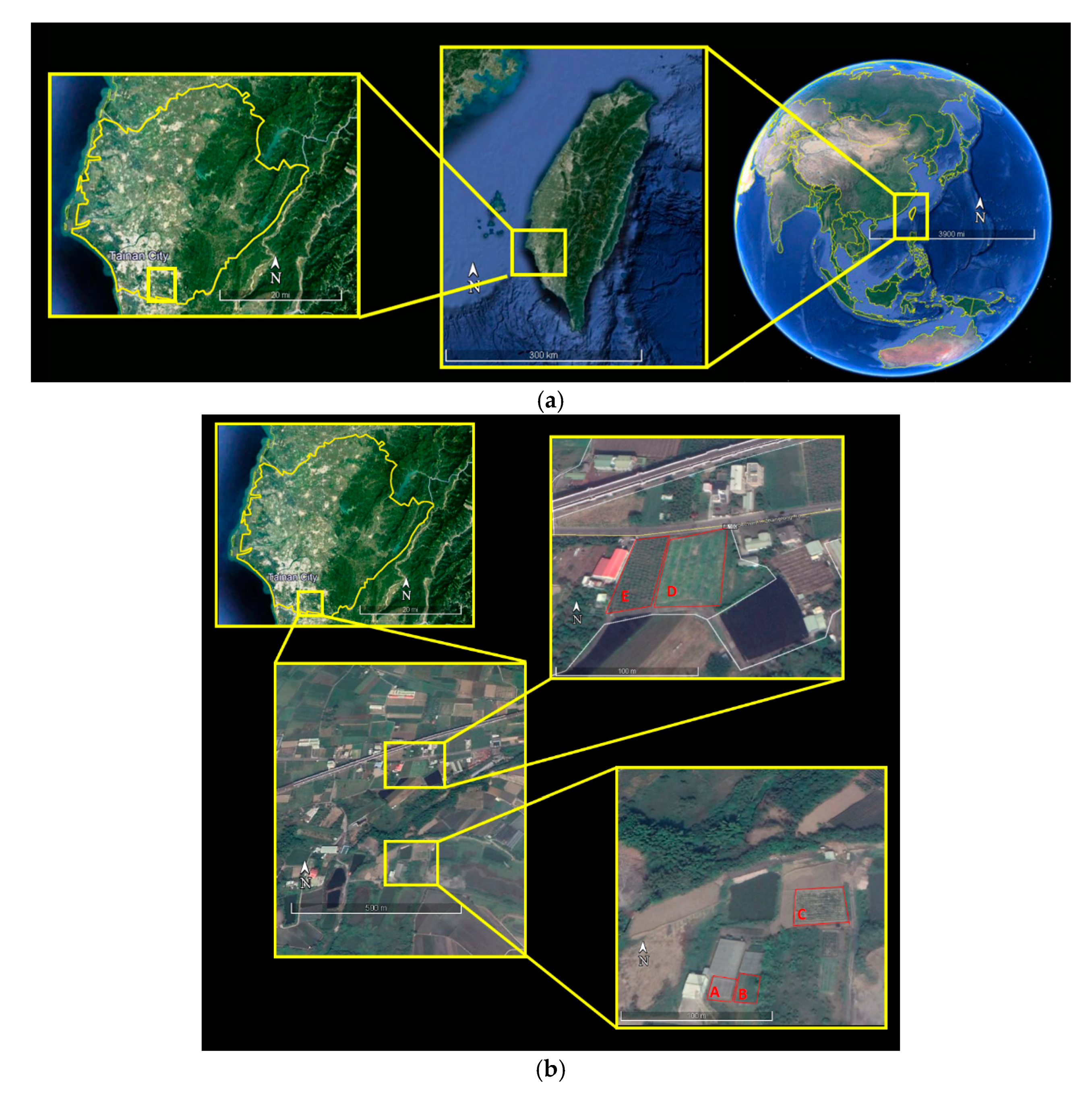
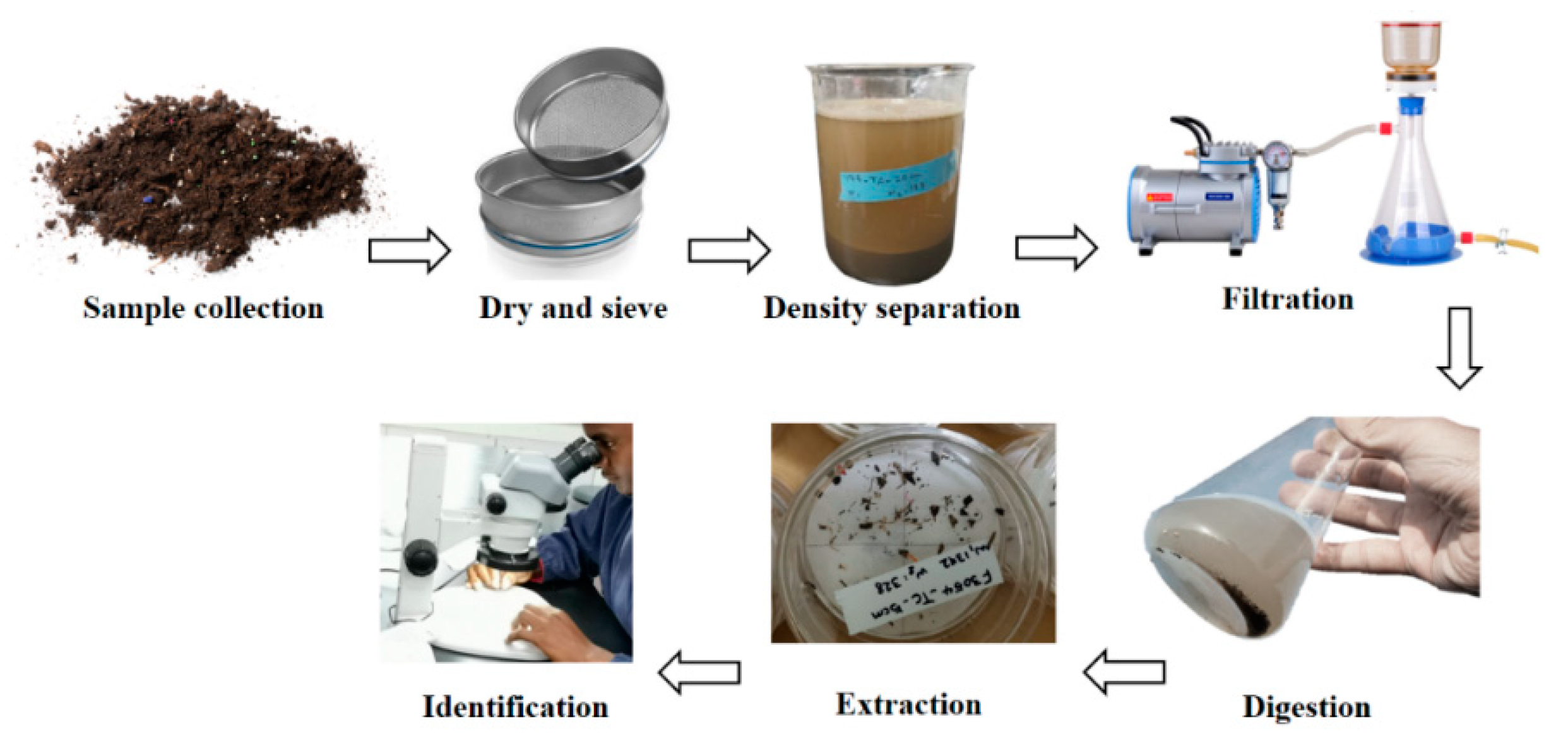
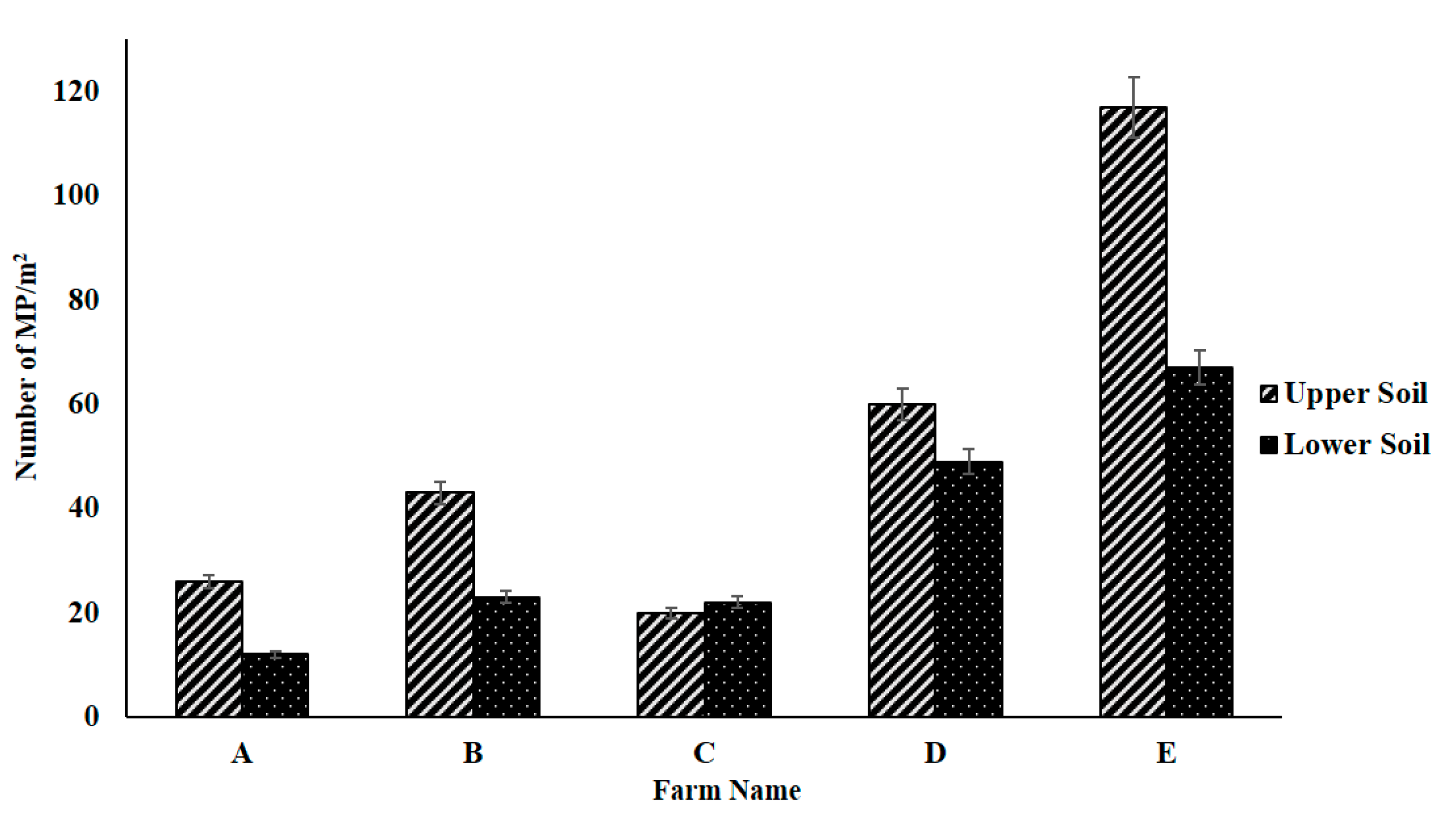
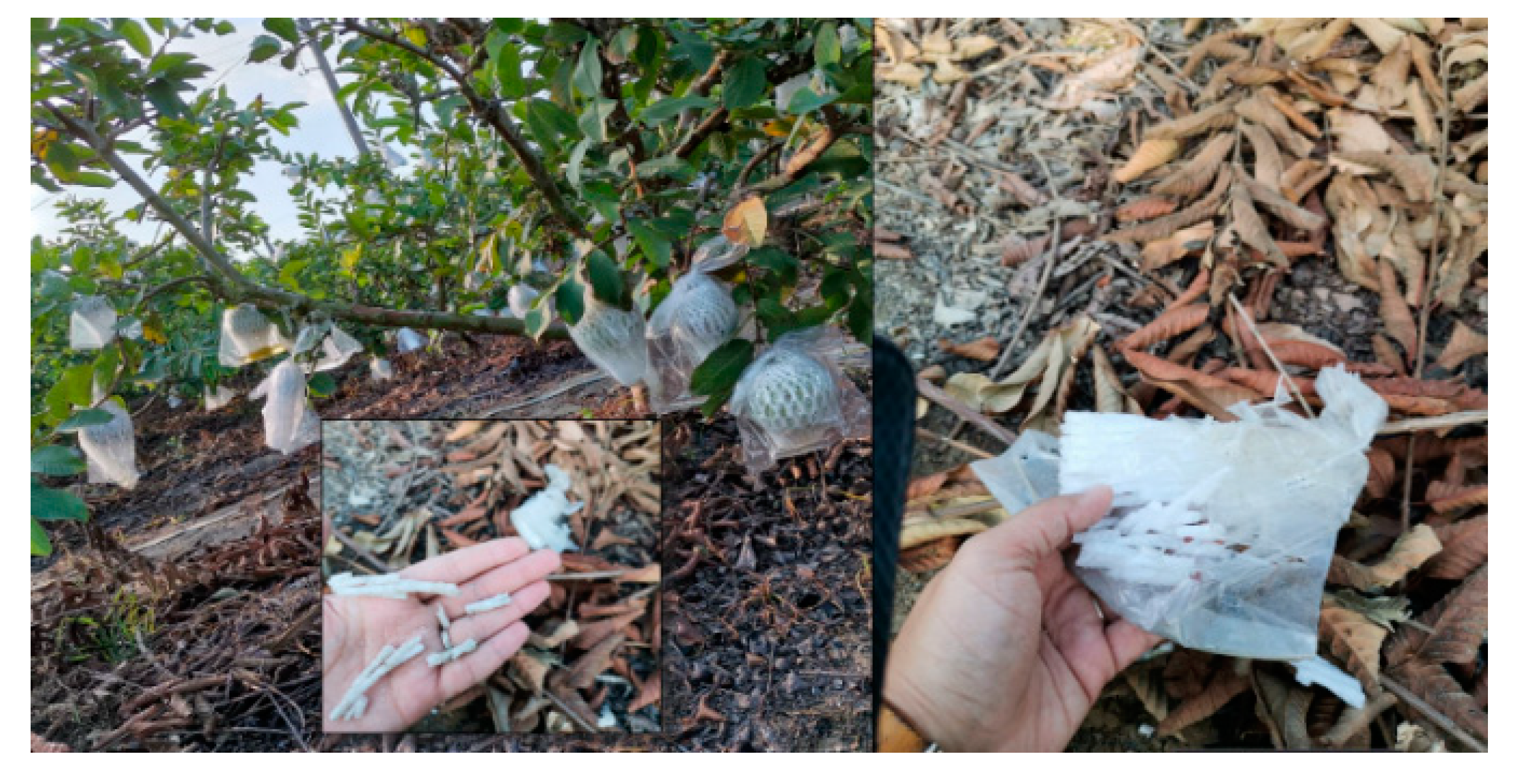

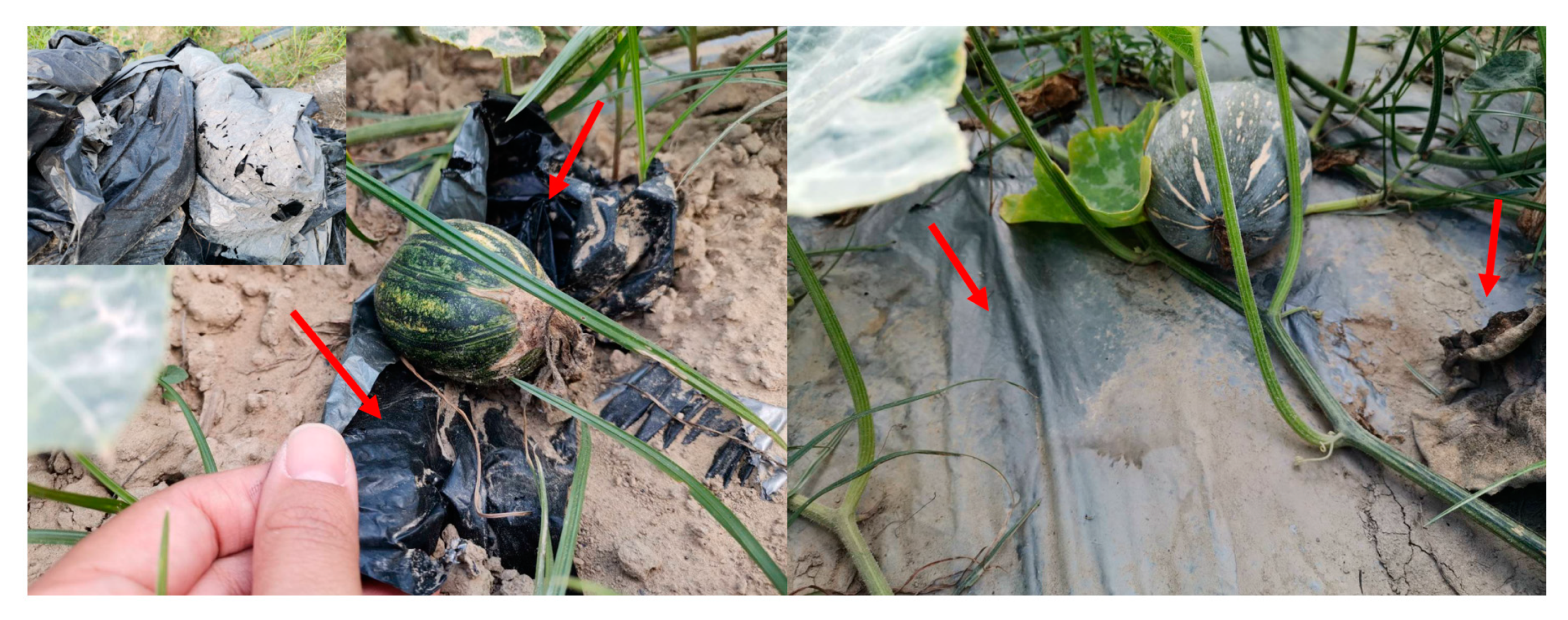
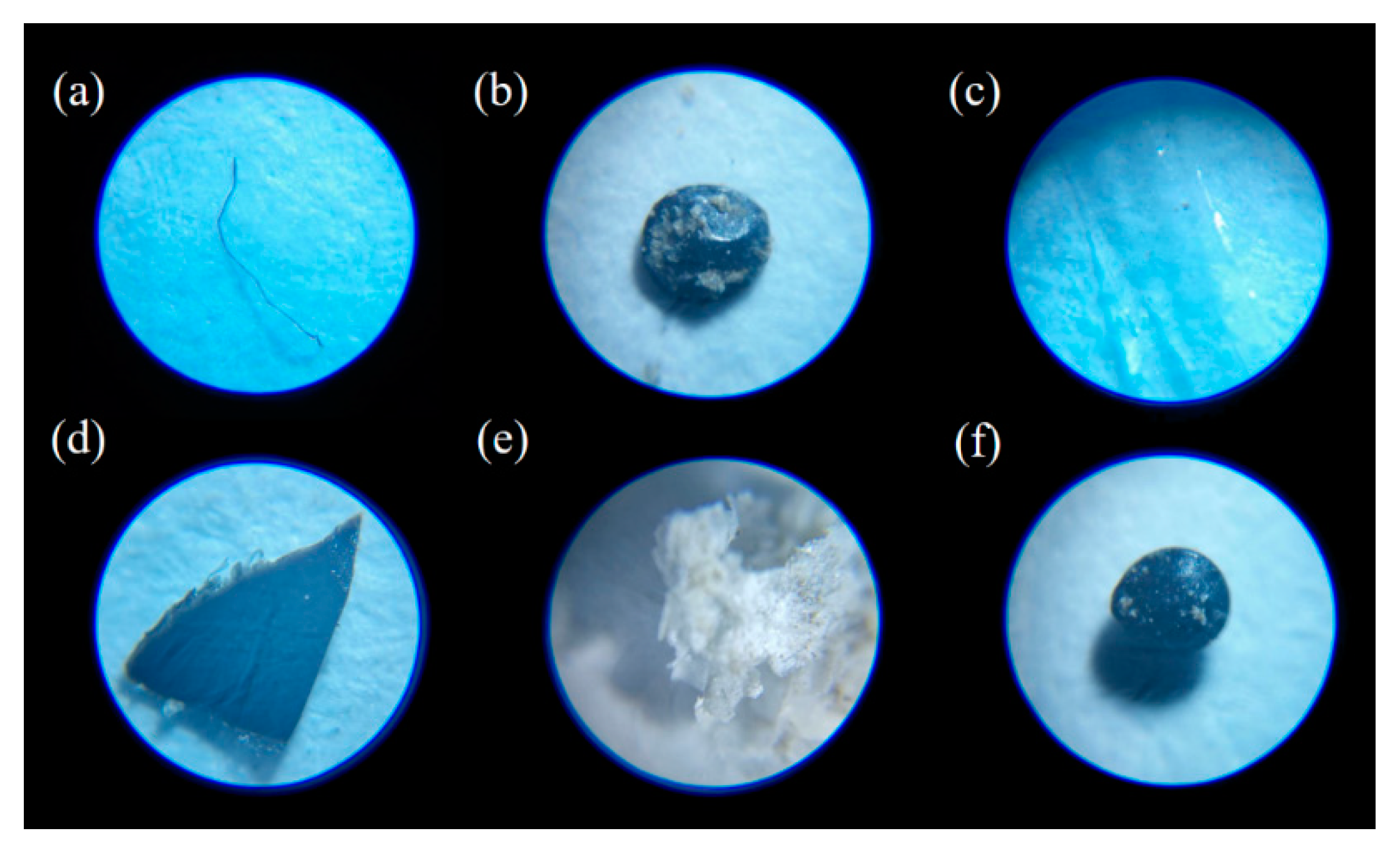
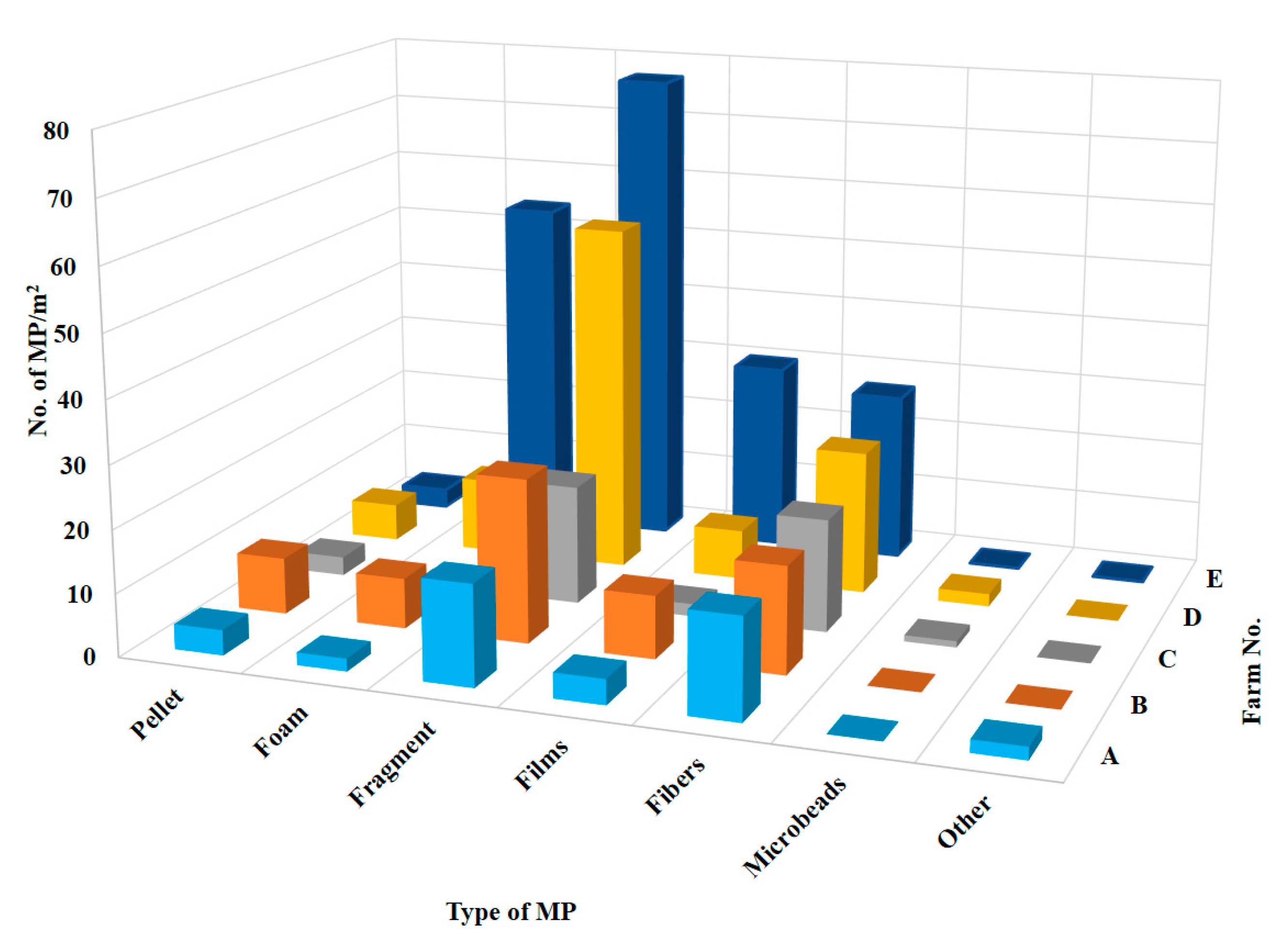
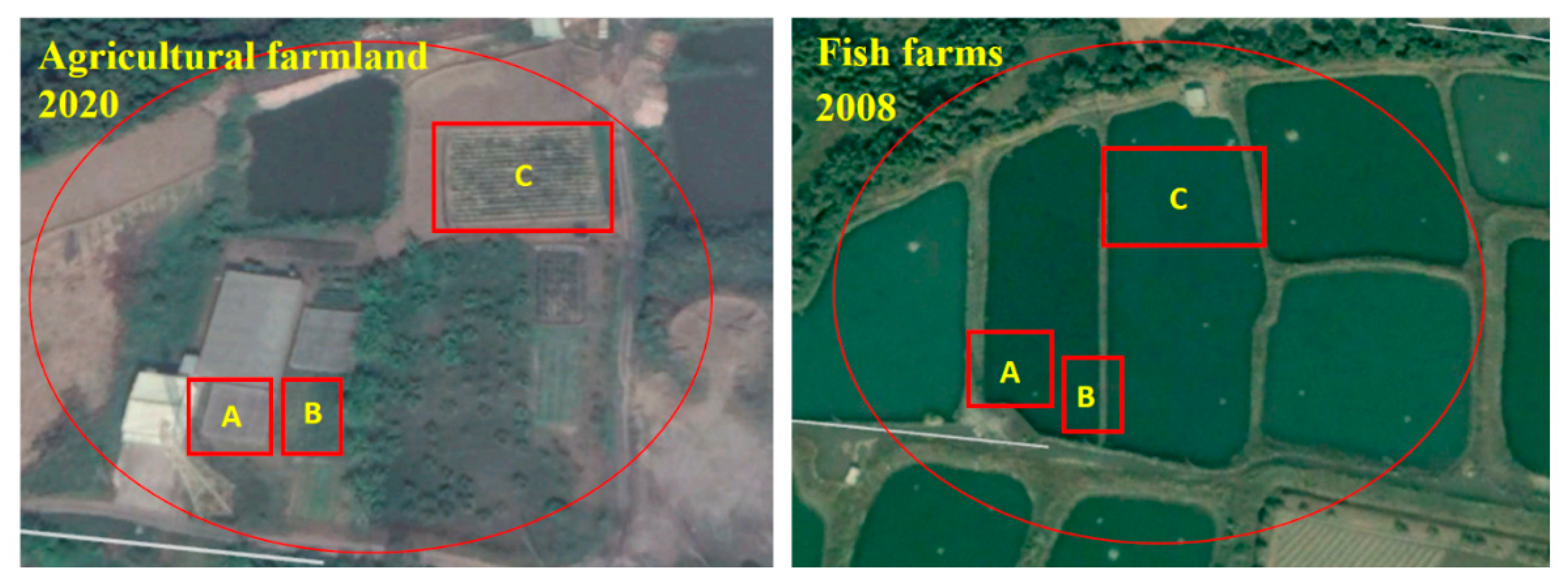

| Farm Name | Location Status (Coordinates) | Area (m2) | Soil Texture | pH | Color | Characteristics |
|---|---|---|---|---|---|---|
| A | Road-away (22.906090, 120.280355) | 177 | Clay | 6.5 | Olive gray | Greenhouse, cultivated with cabbage, organic farming with organic fertilizer |
| B | Road-away (22.906119, 120.280534) | 275 | Clay | 6.5 | Pale olive | Open space, harvested from corn, applying organic fertilizer |
| C | Road-away (22.906679, 120.280993) | 1102 | Silt-loam | 6.5 | Reddish-brown | Open space but fenced around, cultivated with asparagus, applying organic fertilizer |
| D | Roadside (22.909624, 120.280480) | 3054 | Silt-clay-loam | 6.5 | Light Yellowish Brown | Open space, close to a residential area, cultivated with pumpkin, covered with mulch |
| E | Roadside (22.909573, 120.280058) | 1997 | Clay-loam | 6.5 | Light Yellowish Brown | Open space, close to a residential area, cultivated with guava, fruits covered with protective foam |
| Sample Type | Sample Site | Abundance (Items/m2) | Average (Items/m2) | SD * | CV ** |
|---|---|---|---|---|---|
| Upper soil (top 5 cm) | A | 26 | 53.2 | 34.8 | 0.65 |
| B | 43 | ||||
| C | 20 | ||||
| D | 60 | ||||
| E | 117 | ||||
| Lower Soil (deep 20 cm) | A | 12 | 34.6 | 20.3 | 0.58 |
| B | 23 | ||||
| C | 22 | ||||
| D | 49 | ||||
| E | 67 |
Publisher’s Note: MDPI stays neutral with regard to jurisdictional claims in published maps and institutional affiliations. |
© 2021 by the authors. Licensee MDPI, Basel, Switzerland. This article is an open access article distributed under the terms and conditions of the Creative Commons Attribution (CC BY) license (https://creativecommons.org/licenses/by/4.0/).
Share and Cite
Fakour, H.; Lo, S.-L.; Yoashi, N.T.; Massao, A.M.; Lema, N.N.; Mkhontfo, F.B.; Jomalema, P.C.; Jumanne, N.S.; Mbuya, B.H.; Mtweve, J.T.; et al. Quantification and Analysis of Microplastics in Farmland Soils: Characterization, Sources, and Pathways. Agriculture 2021, 11, 330. https://doi.org/10.3390/agriculture11040330
Fakour H, Lo S-L, Yoashi NT, Massao AM, Lema NN, Mkhontfo FB, Jomalema PC, Jumanne NS, Mbuya BH, Mtweve JT, et al. Quantification and Analysis of Microplastics in Farmland Soils: Characterization, Sources, and Pathways. Agriculture. 2021; 11(4):330. https://doi.org/10.3390/agriculture11040330
Chicago/Turabian StyleFakour, Hoda, Shang-Lien Lo, Nathan Thadeo Yoashi, Angelbetter Marselian Massao, Nelson Naboth Lema, Fezile Bethusile Mkhontfo, Patrick Chris Jomalema, Nasra Shabani Jumanne, Bright Hubert Mbuya, James Travor Mtweve, and et al. 2021. "Quantification and Analysis of Microplastics in Farmland Soils: Characterization, Sources, and Pathways" Agriculture 11, no. 4: 330. https://doi.org/10.3390/agriculture11040330
APA StyleFakour, H., Lo, S.-L., Yoashi, N. T., Massao, A. M., Lema, N. N., Mkhontfo, F. B., Jomalema, P. C., Jumanne, N. S., Mbuya, B. H., Mtweve, J. T., & Imani, M. (2021). Quantification and Analysis of Microplastics in Farmland Soils: Characterization, Sources, and Pathways. Agriculture, 11(4), 330. https://doi.org/10.3390/agriculture11040330





